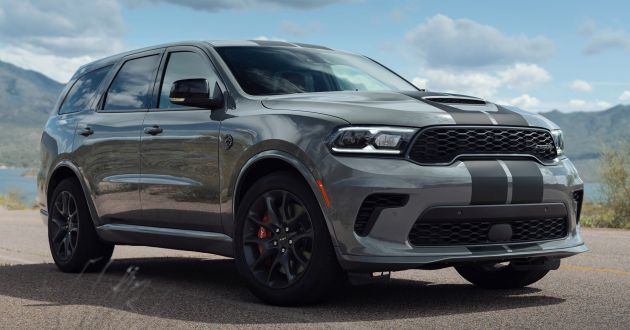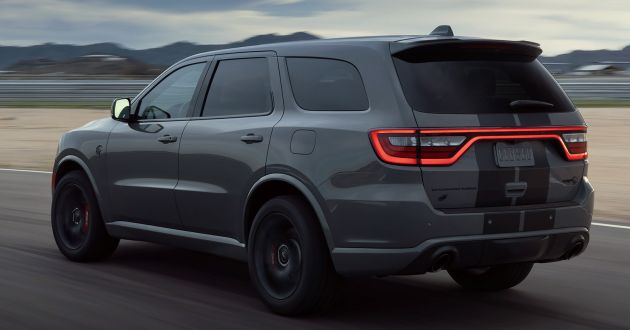[ad_1]
The Dodge Durango has been given a refresh for the 2021 model year, which sees the addition of a new SRT Hellcat variant, so you pretty much know what to expect. Welcome, everyone, to the world’s most powerful series production SUV.
At the heart of the Durango SRT Hellcat is a 6.2 litre supercharged HEMI V8 that pushes out 710 hp and 875 Nm of torque. While the latter is identical to what was offered by the previous king of the hill, the Jeep Grand Cherokee Trackhawk, the SRT Hellcat has three horsepower more to take the crown, although it is still shy of the 717 hp and 889 Nm offered by the Challenger and Charger in SRT Hellcat guise.
Compared to German rivals, Dodge’s offering beats the BMW X5 M Competition (617 hp and 750 Nm), Mercedes-AMG GLE 63 S 4Matic+ (603 hp and 850 Nm) and even the Porsche Cayenne Turbo (542 hp and 770 Nm) – the electrified Cayenne Turbo S E-Hybrid comes close with 671 hp and 900 Nm.
To achieve those figures, the model sports a 2.38 litre supercharger with twin-screw rotors capable of spinning at up to 14,600 rpm and delivering boost pressures as high as 11.6 psi. To make sure everything remains cool, there are charge air coolers integrated into the supercharger, comprised of a water pump, coolant reservoir and heat exchanger to keep intake air temperatures below 60 degrees Celsius.
Other facts include forged internals (crankshaft, connecting rods and pistons), a specially tuned crankshaft damper burst tested to 13,000 rpm, piston-cooling oil jets, aluminium-alloy cylinder heads, along with sodium-cooled exhaust valves, hollow-stem intake valves and steel-alloy heads that stand up to temperatures as high 900 degrees Celsius. The SUV also sports a cold-air scoop to feed the 92-mm throttle body and two high-flow variable pressure fuel pumps.
Getting the power down to the road is the task of an eight-speed TorqueFlite 8HP95 automatic transmission – the same one used in the Trackhawk – as well as an all-wheel drive system and a set of Pirelli Scorpion Zero 295/45 profile all-season tyres (Pirelli P-Zeros are also available).
In terms of performance, the SRT Hellcat will get from zero to 96 km/h (0-60 mph) in just 3.5 seconds, covers the quarter-mile sprint in 11.5 seconds and has a top speed of 290 km/h. Dodge also says the SUV will lap a 3.4-km road source 1.5 seconds faster than a 2020 Durango SRT 392, which equates to nine car lengths after one lap.
Power aside, the model also comes with upgraded suspension that is more responsive with a 20% increase in total rebound control and 18% stiffer rear damper top mounts. The company also claims reduced understeer and body roll, improving responsiveness when attacking a corner.
There are also Brembo high-performance brakes, with six-piston calipers and 400 mm rotors at the front, while the rear gets four-piston calipers and 350 mm rotors instead. Stopping from 96 km/h is said to take just 35 metres, which is quite a feat for a vehicle of this size.
To make sure the SRT Hellcat stands out, it doesn’t get fog lamps at the front, with the openings being used to help cool the massive engine. There’s also a two-piece front splitter and Hellcat-specific 20-inch wheels, while the rear features a spoiler that generates 181 kg of downforce at the vehicle’s top speed.
The facelift also sees a new grille that mimics the look of the Charger, paired with slimmer headlamps and LED rear lighting. As for the interior, changes include a larger centre console storage cubby and a redesigned centre stack, the latter serving to accommodate a 10.1-inch touchscreen for the Uconnect 5 infotainment system that has the Performance Pages app in the SRT Hellcat.
The rest of line-up – SXT, GT, Citadel, R/T and SRT 392 – also sees some changes. The R/T with the Tow N Go package and the SRT 392 have a best-in-class towing capability of 3,946 kg (8,700 pounds). The Tow N Go package includes items that are standard on the SRT Hellcat, including bumpers, fender flares, 20-inch wheels, the aforementioned Brembo brakes, adaptive damping suspension and a limited-slip differential.
Engine-wise, the SRT 392 gets a 6.4 litre HEMI V8 delivering 475 hp and 637 Nm, while the R/T and Citadel are powered by a 5.7 litre HEMI V8 rated at 360 hp and 529 Nm. The Citadel also gets a 3.6 litre Pentastar V6 with 295 hp and 352 Nm that is shared with the SXT and GT variants. An eight-speed automatic is standard, with rear- and all-wheel drive available.
The full suite of safety features, including adaptive cruise control, blind-spot monitoring, rear cross traffic detection, forward collision warning with active braking, advanced brake assist and LaneSense lane departure warning with lane keep assist comes standard on the Citadel onwards.
2021 Dodge Durango SRT Hellcat
2021 Dodge Durango R/T Tow N Go
2021 Dodge Durango Citadel
[ad_2]
Source link








